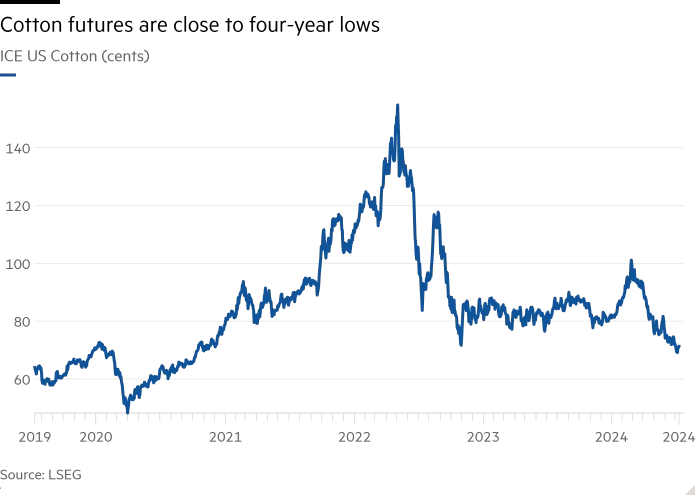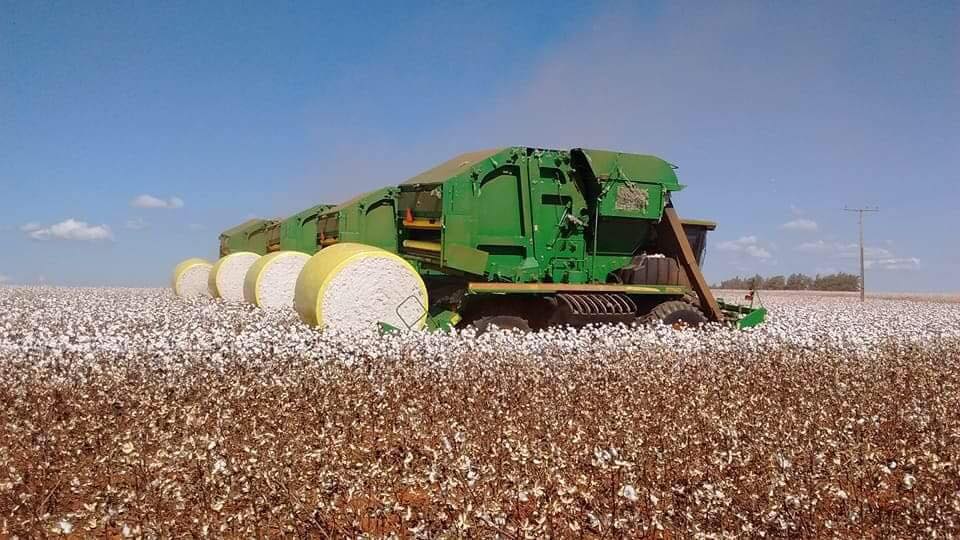Susannah Savage in London and Michael Pooler in São Paulo
The price of cotton has tumbled as growing competition between the world’s biggest producers drives up supply while cost-conscious shoppers seek out clothes made out of cheaper fabrics.
ICE cotton futures fell below $0.69 a pound this month, the lowest level since October 2020 and less than half their 10-year peak hit in May 2022.
Prices have been dragged down by a sharp rise in production in Brazil, which recently overtook the US as the world’s largest cotton exporter. The South American country exported 12.4mn bales in the 2023-24 harvest season compared with 11.8mn that came out of the US, according to estimates by the US Department of Agriculture. Australia, the world’s third-biggest exporter, shipped 5.8mn bales.
“With Brazil expanding their production, going into the future we have to worry about competition from them,” said Dr Jody Campiche, vice-president of economics and policy analysis of the National Cotton Council of America.

Brazil has steadily increased its acreage of cotton over the past decade, reaching 1.87mn hectares planted for the 2023-2024 season, according to USDA estimates, a 13 per cent increase on the previous year. Low prices for corn — which has been falling for the past two years — have pushed farmers in Brazil’s Mato Grosso state to plant cotton instead of a second corn crop, according to a report by the US Department of Agriculture.
“We don’t have incentives or subsidies, a fact that pressures us to produce more and more per hectare,” said Carlos Alberto Moresco, who runs three farms in the Brazilian state of Goiás with a variety of crops including soy, corn, wheat, tomatoes, sorghum and cotton.
“Brazil has the cheapest cotton in the world. We produce almost 2 tonnes of lint [processed cotton] per hectare, which is not heard of elsewhere,” he added.
Brazil’s soaring output has more than offset the impact of consecutive years of drought in the US, which have knocked production there to 12.5mn bales in 2023 from 17.5mn two years earlier. In 2022, the country produced its smallest harvest in a decade after months of hot, dry weather forced growers in Texas, the biggest producing state, to abandon 6mn acres of crop.
While global prices spiked that year, they have since come down, even as US production has fallen.
Meanwhile, global demand for cotton has fallen since the coronavirus pandemic as an economic slowdown and a sharp rise in interest rates have squeezed consumers.
Over the past few years shoppers have increasingly opted for polyester and other man-made petroleum-based fabrics, which are cheaper and quicker to produce than cotton, but have a much larger environmental toll.
Some in the market also blame computer-driven hedge funds that try to profit from latching on to market trends either up or down, claiming that selling by these quant managers has contributed to falling prices.
“I think an unholy amount of activity here can be traced to the funds,” said Herman Kohlmeyer, a cotton broker at Michael J Nugent in New Orleans.
Faced with low prices, high production costs resulting from rising fertiliser prices and other factors, and increasing competition, American farmers are struggling, although many are still planting cotton. “There’s no doubt that this will be an unhappy year for them,” said Kohlmeyer.
China and India are the world’s largest cotton producers, but most of their output goes to domestic buyers.
Brazil’s cotton harvests have grown significantly over the past two decades, mirroring its emergence as a farming powerhouse. The Latin American nation is the biggest exporter of soyabeans, orange juice, sugar and coffee; and last year it surpassed the US as top shipper of corn, although is not expected to retain the title.
Campaigners have raised concerns over the environmental and social impact of cotton farming in Brazil. But Alexandre Schenkel, president of the Brazilian Cotton Producers Association (Abrapa) defended the sector’s record on sustainability.
“Today, producers in Brazil do not deforest to plant cotton. There’s a great effort to use open areas that have already been used for other crops or livestock,” he said.
US production was the swing factor for prices, Schenkel added, predicting that American farmers would have better results in the next harvest. Prices could also be affected by bad harvests in important producers such as Australia, China, India or Pakistan.
Prices are unlikely to rebound anytime soon, according to Campiche. Harvest levels in the US were on track to return to 2021 levels this year, while Brazil and Australia are also set to produce big crops, she said.
“Until we get world cotton demand back up we’re not going to get prices coming back up,” said Campiche. “If we’re going to see higher cotton demand in the future, it’s going to come down to: will consumers decide they want to pay more for products that are sustainable?”
Additional reporting by Beatriz Langella
Πηγή: ft.com

